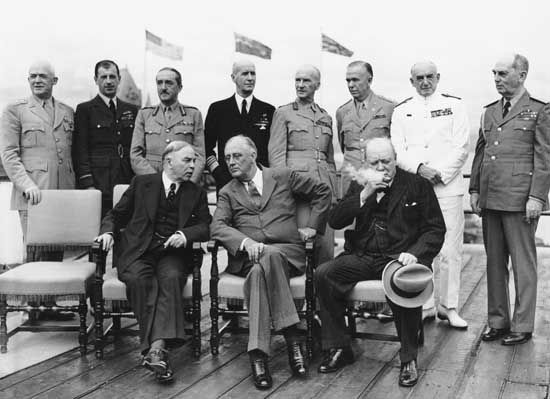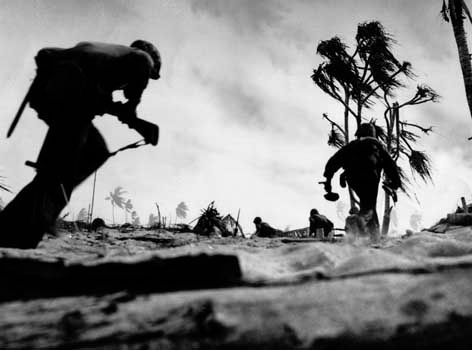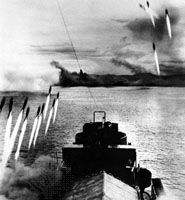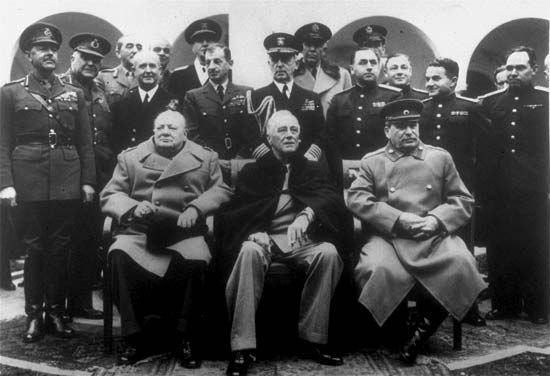World War II
Our editors will review what you’ve submitted and determine whether to revise the article.
- Council on Foreign Relations - Education - Why Did World War II Happen?
- The National WWII Museum - World War II and Popular Culture
- Academia - Forgotten alliance: Hitler-Stalin pact of 1939 and the outcome of Second World War
- Weapons and Warfare - World War II
- National Center for Biotechnology Information - PubMed Central - The Effects of World War II on Economic and Health Outcomes across Europe
- Air and Space Forces Magazine - Casualties
- New Zealand History - Second World War
- Ohio State University - Origins - The Nazis Take Poland and the Start of World War II
- History Learning Site - World War Two
- Also called:
- Second World War
- Date:
- September 3, 1939 - September 2, 1945
- Participants:
- Canada
- China
- France
- Germany
- India
- Italy
- Japan
- Soviet Union
- United Kingdom
- United States
- Major Events:
- Battle of France
- Holocaust
- North Africa campaigns
- Pacific War
- Eastern Front
What was the cause of World War II?
World War II began in Europe on September 1, 1939, when Germany invaded Poland. Great Britain and France responded by declaring war on Germany on September 3. The war between the U.S.S.R. and Germany began on June 22, 1941, with Operation Barbarossa, the German invasion of the Soviet Union. The war in the Pacific began on December 7/8, 1941, when Japan attacked the American naval base at Pearl Harbor and other American, Dutch, and British military installations throughout Asia.
What countries fought in World War II?
The main combatants were the Axis powers (Germany, Italy, and Japan) and the Allies (France, Great Britain, the United States, the Soviet Union, and, to a lesser extent, China).
Who were the leaders during World War II?
The Allied powers were led by Winston Churchill (United Kingdom); Joseph Stalin (Soviet Union); Charles de Gaulle (France); and Franklin D. Roosevelt and Harry S. Truman (United States). The Axis powers were led by Adolf Hitler (Germany), Benito Mussolini (Italy), and Hideki Tojo (Japan).
What were the turning points of World War II?
The war in the Pacific turned against Japan during the Battle of Midway (June 3–6, 1942), an American victory that destroyed the Japanese first-line carrier force and, together with the Battle of Guadalcanal, ended Japan’s ability to prosecute an offensive war.
The tide of the war in Europe shifted with the Soviet victory at the Battle of Stalingrad (February 1943). More than one million Soviet troops and tens of thousands of civilians died in the defense of the city, but the destruction of two entire German armies marked the beginning of the end of the Third Reich.
How did World War II end?
The Allied landings at Normandy on June 6, 1944, opened a second front in Europe, and Germany’s abortive offensive at the Ardennes in the winter of 1944–45 marked the Third Reich’s final push in the west. The Red Army advanced from the east and effectively claimed all the territory under its control for the Soviet sphere. The Allied armies converged on Berlin. Adolf Hitler committed suicide on April 30, 1945, and the war in Europe ended on May 8.
The American “island hopping” campaign had destroyed key Japanese installations throughout the Pacific while allowing bypassed islands to wither on the vine. Hundreds of thousands were killed in firebombings of Japanese cities, and the atomic bombings of Hiroshima and Nagasaki in August 1945 knocked Japan out of the war.
How many people died during World War II?
Estimates of the total number of people killed during World War II have ranged from 35,000,000 to 60,000,000—a significant span, because statistics about the war’s casualties are inexact. The Soviet Union and China are believed to have suffered the most total casualties, while an estimated 5,800,000 Poles died, which represents about 20 percent of Poland’s prewar population. About 4,200,000 Germans died, and about 1,972,000 Japanese died. In all, the scale of human losses during World War II was vast. A table that details estimated deaths by country is available here.
News •
World War II, conflict that involved virtually every part of the world during the years 1939–45. The principal belligerents were the Axis powers—Germany, Italy, and Japan—and the Allies—France, Great Britain, the United States, the Soviet Union, and, to a lesser extent, China. The war was in many respects a continuation, after an uneasy 20-year hiatus, of the disputes left unsettled by World War I. The 40,000,000–50,000,000 deaths incurred in World War II make it the bloodiest conflict, as well as the largest war, in history.
Along with World War I, World War II was one of the great watersheds of 20th-century geopolitical history. It resulted in the extension of the Soviet Union’s power to nations of eastern Europe, enabled a communist movement to eventually achieve power in China, and marked the decisive shift of power in the world away from the states of western Europe and toward the United States and the Soviet Union.
(Read Sir John Keegan’s Britannica entry on the Normandy Invasion.)
Axis initiative and Allied reaction
The outbreak of war
By the early part of 1939 the German dictator Adolf Hitler had become determined to invade and occupy Poland. Poland, for its part, had guarantees of French and British military support should it be attacked by Germany. Hitler intended to invade Poland anyway, but first he had to neutralize the possibility that the Soviet Union would resist the invasion of its western neighbour. Secret negotiations led on August 23–24 to the signing of the German-Soviet Nonaggression Pact in Moscow. In a secret protocol of this pact, the Germans and the Soviets agreed that Poland should be divided between them, with the western third of the country going to Germany and the eastern two-thirds being taken over by the U.S.S.R.
Having achieved this cynical agreement, the other provisions of which stupefied Europe even without divulgence of the secret protocol, Hitler thought that Germany could attack Poland with no danger of Soviet or British intervention and gave orders for the invasion to start on August 26. News of the signing, on August 25, of a formal treaty of mutual assistance between Great Britain and Poland (to supersede a previous though temporary agreement) caused him to postpone the start of hostilities for a few days. He was still determined, however, to ignore the diplomatic efforts of the western powers to restrain him. Finally, at 12:40 pm on August 31, 1939, Hitler ordered hostilities against Poland to start at 4:45 the next morning. The invasion began as ordered. In response, Great Britain and France declared war on Germany on September 3, at 11:00 am and at 5:00 pm, respectively. World War II had begun.

































































































































































